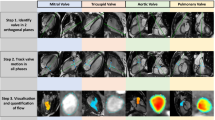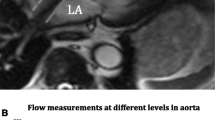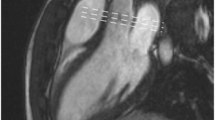Abstract
Cardiovascular magnetic resonance (CMR) has important contributions to make to the assessment of heart valve disease. These can be complementary to routine echocardiographic assessment, for example in the quantification of valve regurgitation and clarification of the nature and level(s) of right or left ventricular outflow tract obstruction. In ischemic mitral regurgitation, CMR allows the assessment of myocardial scarring and viability as well as the nature of valve dysfunction. CMR provides a noninvasive alternative to echocardiography in patients with inconsistent findings or limited acoustic access. For studies of multidirectional flow, CMR can measure all three directional components of velocity in voxels distributed in three dimensions and through the phases of the cycle. More clinically applicable, however, are volumetric flow measurements, forward or regurgitant, through planes transecting one or both great arteries. These derived measurements are prone to errors caused by slight background phase offsets, which may require appropriate correction.


Similar content being viewed by others
References
Papers of particular interest, published recently, have been highlighted as:• Of importance
Bonow RO, Carabello BA, Kanu C, et al.: ACC/AHA Guidelines for the Management of Patients with Valvular Heart Disease. Circulation 2006, 114:e84–e231.
Kilner PJ, Geva T, Kaemmerer H, et al.: Recommendations for cardiovascular magnetic resonance in adults with congenital heart disease from the respective Working Groups of the European Society of Cardiology. European Heart J 2010, In press.
Devos DG, Kilner PJ: Calculations of cardiovascular shunts and regurgitation using magnetic resonance ventricular volume and aortic and pulmonary flow measurements. Eur Radiol 2009 Aug 29 (Epub ahead of print).
• Gelfand EV, Hughes S, Hauser TH, et al.: Severity of mitral and aortic regurgitation as assessed by cardiovascular magnetic resonance: optimizing correlation with Doppler echocardiography. J Cardiovasc Magn Reson 2006, 8:503–507. This is a comparison of CMR with echocardiographic measures of severity, suggesting that slightly lower thresholds of CMR-measured regurgitant fraction should be used. This may in part be explained by the underestimation of aortic regurgitation by CMR due to upward diastolic movement of the root.
• Gabriel RS, Kerr AJ, Raffel OC, et al.: Mapping of mitral regurgitant defects by cardiovascular magnetic resonance in moderate or severe mitral regurgitation secondary to mitral valve prolapse. J Cardiovasc Magn Reson 2008, 10:16. This article makes use of stacks of cines to visualize all parts of the mitral valve.
Chan KM, Wage R, Symmonds K, et al.: Towards comprehensive assessment of mitral regurgitation using cardiovascular magnetic resonance. J Cardiovasc Magn Reson 2008, 10:61.
Kilner PJ, Sievers B, Meyer GP, Ho SY: Double-chambered right ventricle or sub-infundibular stenosis assessed by cardiovascular magnetic resonance. J Cardiovasc Magn Reson 2002, 4:373–379.
Schlosser T, Malyar N, Jochims M, et al.: Quantification of aortic valve stenosis in MRI-comparison of steady-state free precession and fast low-angle shot sequences. Eur Radiol 2007, 17:1284–1290.
Picano E, Pibarot P, Lancellotti P, et al.: The emerging role of exercise testing and stress echocardiography in valvular heart disease. J Am Coll Cardiol 2009, 54:2251–2260.
Klein AA, Snell A, Nashef SA, et al.: The impact of intra-operative transoesophageal echocardiography on cardiac surgical practice. Anaesthesia 2009, 64:947–952.
Shellock FG, Spinazzi A: MRI safety update 2008: part 2, screening patients for MRI. Am J Roentgenol 2008, 191:1140–1149.
Gatehouse PD, Keegan J, Crowe LA, et al.: Applications of phase-contrast flow and velocity imaging in cardiovascular MRI. Eur Radiol 2005, 15:2172–2184.
Petersen SE, Voigtlander T, Kreitner KF, et al.: Quantification of shunt volumes in congenital heart diseases using a breath-hold MR phase contrast technique-comparison with oximetry. Int J Cardiovasc Imaging 2002, 18:53–60.
Colletti PM: Evaluation of intracardiac shunts with cardiac magnetic resonance. Curr Cardiol Rep 2005, 7:52–58.
Rebergen SA, Chin JGL, Ottenkamp J, et al.: Pulmonary regurgitation in the late post-operative follow-up of tetralogy of Fallot: volumetric quantification by nuclear magnetic resonance velocity mapping. Circulation 1993, 88:2257–2266.
Hundley WG, Li HF, Willard JE, et al.: Magnetic resonance imaging assessment of the severity of mitral regurgitation. Circulation 1995, 92:1151–1158.
Kon MW, Myerson SG, Moat NE, Pennell DJ: Quantification of regurgitant fraction in mitral regurgitation by cardiovascular magnetic resonance: comparison of techniques. J Heart Valve Dis 2004, 13:600–607.
Chai P, Mohiaddin R: How we perform cardiovascular magnetic resonance flow assessment using phase-contrast velocity mapping. J Cardiovasc Magn Reson 2005, 7:705–716.
• Chernobelsky A, Shubayev O, Comeau CR, Wolff SD: Baseline correction of phase contrast images improves quantification of blood flow in the great vessels. J Cardiovasc Magn Res 2007, 9:681–685. This article showed that errors in derived measurements of aortic relative to pulmonary flow in volunteers could be corrected using subsequent static phantom acquisition.
Kilner PJ, Gatehouse PD, Firmin DN: Flow measurement by magnetic resonance: a unique asset worth optimising. J Cardiovasc Magn Res 2007, 9:723–728.
• Gatehouse PD, Rolf MP, Graves MJ, et al.: Flow measurement by magnetic resonance: a multi-centre multi-vendor study of background phase offset errors that can compromise the accuracy of derived regurgitant or shunt flow measurements. JCMR 2010, In press. This study using static gel phantoms in three types of 1.5-Tesla magnet confirmed the problem of background phase offset errors that can compromise the accuracy of uncorrected derived breath-hold measurements of flow. However, this should not undermine a clinically useful method, but rather point to the need for appropriate acquisition and/or correction, with encouragement to vendors to further optimize hardware and software.
Lankhaar JW, Hofman MB, Marcus JT, et al.: Correction of phase offset errors in main pulmonary artery flow quantification. J Magn Reson Imaging 2005, 22:73–79.
Kozerke S, Scheidegger MB, Pedersen EM, Boesiger P: Heart motion adapted cine phase-contrast flow measurements through the aortic valve. Magn Reson Med 1999, 42:970–978.
Kozerke S, Schwitter J, Pedersen EM, Boesiger P: Aortic and mitral regurgitation: quantification using moving slice velocity mapping. J Magn Reson Imaging 2001, 14:106–112.
Redington AN: Determinants and assessment of pulmonary regurgitation in tetralogy of Fallot: practice and pitfalls. Cardiol Clin 2006, 24:631–639.
Kilner PJ, Balossino R, Dubini G, et al.: Pulmonary regurgitation: the effects of varying pulmonary artery compliance, and of increased resistance proximal or distal to the compliance. Int J Cardiol 2009, 133:157–166.
Muthurangu V, Taylor A, Andriantsimiavona R, et al.: Novel method of quantifying pulmonary vascular resistance by use of simultaneous invasive pressure monitoring and phase-contrast magnetic resonance flow. Circulation 2004, 110:826–834.
Pouleur AC, le Polain de Waroux JB, Pasquet A, et al.: Planimetric and continuity equation assessment of aortic valve area: Head to head comparison between cardiac magnetic resonance and echocardiography. J Magn Reson Imaging 2007, 26:1436–1443.
Yap SC, van Geuns RJ, Meijboom FJ, et al.: A simplified continuity equation approach to the quantification of stenotic bicuspid aortic valves using velocity-encoded cardiovascular magnetic resonance. J Cardiovasc Magn Reson 2007, 9:899–906.
O’Brien KR, Gabriel RS, Greiser A, et al.: Aortic valve stenotic area calculation from phase contrast cardiovascular magnetic resonance: the importance of short echo time. J Cardiovasc Magn Reson 2009, 11:49.
Mohiaddin RH, Yang GZ, Kilner PJ: Visualization of flow by vector analysis of multidirectional cine MR velocity mapping. J Comput Assist Tomogr 1994, 18:383–392.
Bogren HG, Buonocore MH: 4D magnetic resonance velocity mapping of blood flow patterns in the aorta in young vs. elderly normal subjects. J Magn Reson Imaging 1999, 10:861–869.
Kilner PJ, Yang GZ, Wilkes AJ, et al.: Asymmetric redirection of flow through the heart. Nature 2000, 13:759–761.
Firmin DN, Gatehouse PD, Konrad JP, et al.: Rapid 7-dimensional imaging of pulsatile flow. London: Computers in Cardiology, IEEE Computer Society; 1993:353–356.
Wigstrom L, Ebbers T, Fyrenius A, et al.: Particle trace visualization of intracardiac flow using time-resolved 3D phase contrast MRI. Magn Reson Med 1999, 41:793–799.
Markl M, Harloff A, Bley TA, et al.: Time-resolved 3D MR velocity mapping at 3 T: improved navigator-gated assessment of vascular anatomy and blood flow. J Magn Reson Imaging 2007, 25:824–831.
Frydrychowicz A, Bley TA, Dittrich S, et al.: Visualization of vascular hemodynamics in a case of a large patent ductus arteriosus using flow sensitive 3D CMR at 3 T. J Cardiovasc Magn Reson 2007, 9:585–587.
Ebbers T, Wigström L, Bolger AF, et al.: Noninvasive measurement of time-varying three-dimensional relative pressure fields within the human heart. J Biomech Eng 2002, 124:288–293.
• Harloff A, Strecker C, Dudler P, et al.: Retrograde embolism from the descending aorta: visualization by multidirectional 3D velocity mapping in cryptogenic stroke. Stroke 2009, 40:1505–1508. This is an impressive example of the application of a novel approach to a previously unexplained clinical occurrence.
Markl M, Arnold R, Hirtler D, et al.: Three-dimensional flow characteristics in aortic coarctation and poststenotic dilatation. J Comput Assist Tomogr 2009, 33:776–778.
Hope MD, Meadows AK, Hope TA, et al.: Images in cardiovascular medicine. Evaluation of bicuspid aortic valve and aortic coarctation with 4D flow magnetic resonance imaging. Circulation 2008, 117:2818–2819.
Reiter G, Reiter U, Kovacs G, et al.: Magnetic resonance-derived 3-dimensional blood flow patterns in the main pulmonary artery as a marker of pulmonary hypertension and a measure of elevated mean pulmonary arterial pressure. Circ Cardiovasc Imaging 2008, 1:23–30.
Bolger AF, Heiberg E, Karlsson M, et al.: Transit of blood flow through the human left ventricle mapped by cardiovascular magnetic resonance. J Cardiovasc Magn Reson 2007, 9:741–747.
Roes SD, Hammer S, van der Geest RJ, et al.: Flow assessment through four heart valves simultaneously using 3-dimensional 3-directional velocity-encoded magnetic resonance imaging with retrospective valve tracking in healthy volunteers and patients with valvular regurgitation. Invest Radiol 2009 Aug 29 (Epub ahead of print).
Acknowledgment
Philip Kilner is supported by the British Heart Foundation.
Disclosure
No potential conflict of interest relevant to this article was reported.
Author information
Authors and Affiliations
Corresponding author
Rights and permissions
About this article
Cite this article
Kilner, P.J. Flow and Valvular Disease Studied by Cardiovascular Magnetic Resonance. curr cardiovasc imaging rep 3, 74–82 (2010). https://doi.org/10.1007/s12410-010-9008-x
Published:
Issue Date:
DOI: https://doi.org/10.1007/s12410-010-9008-x




